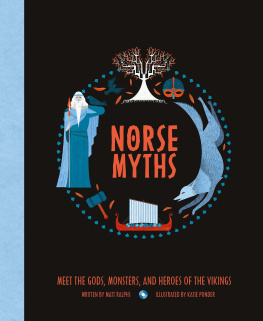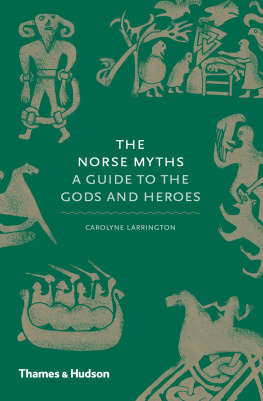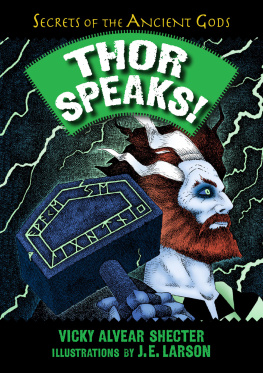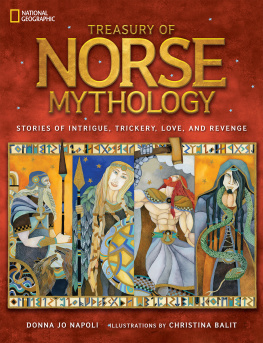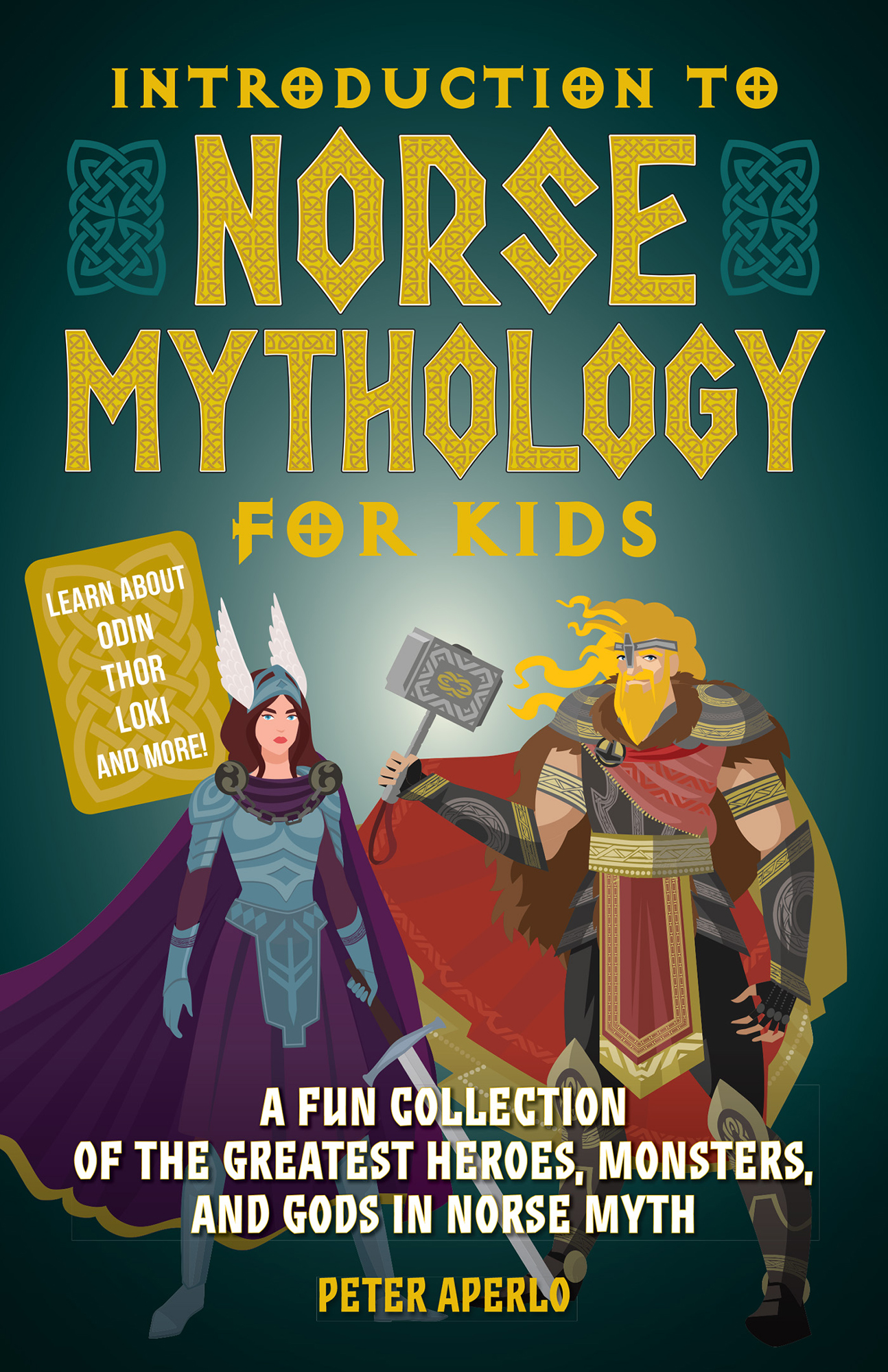Contents
Guide
Introduction to Norse Mythology for Kids
Learn Odin Thor Loki and More
A Fun Collection of the Greatest Heroes, Monsters, and Gods in Norse Myth
Peter Aperlo
Text 2015, 2021 Peter Aperlo. Illustrations 2015, 2021 Valentin Ramon. Concept and design 2015, 2021 Ulysses Press and its licensors. All rights reserved. Any unauthorized duplication in whole or in part or dissemination of this edition by any means (including but not limited to photocopying, electronic devices, digital versions, and the internet) will be prosecuted to the fullest extent of the law.
Published in the United States by:
Ulysses Press
PO Box 3440
Berkeley, CA 94703
www.ulyssespress.com
ISBN: 978-1-64604-190-9
ISBN: 978-1-64604-215-9 (ebook)
Library of Congress Control Number: 2021931505
Acquisitions editor: Casie Vogel
Managing editor: Claire Chun
Project manager: Bridget Thoreson
Proofreader: Renee Rutledge
Front cover design: Jake Flaherty
Cover images: from shutterstock.com Thor delcarmat; Valkyrie GoodStudio; knot graphic Hoika Mikhail
Interior illustrations: Valentin Ramon
For Professor Jesse Byock, who has forgotten more about the Vikings than any of us will ever know.
And for Lee Fair, who taught me the most important question in the study of history is why?
INTRODUCTION
Call them Vikings or call them Norsemen, chances are youve seen plenty of these guys in pop culture over the years. Movies, TV, books, and comics are filled with the thrilling and often bloody adventures of these shaggy, seagoing barbarians. And with them come amazing stories of heroes, gods, and monsters.
Youve probably already heard some of their names, such as Odin, Thor, Loki, and the Midgard Serpent. Others may be new to youlike Bodvar Bjarki. In this book youll read stories that are comical as well as gruesome, some that are incredibly noble, and others that are simply mystifying.
From the creation of the world to the final battle of Ragnarok between the gods and the forces of evil, these are stories that are crucial to know if you want to fully understand the world of the Vikings.
Where Did These Stories Come From?
A thousand years ago, the Vikings and other people of northern Europethe region we now know as Scandinaviarecorded vibrant sagas and poems. They collected an impressive array of stories revolving around ancient myths and beliefsand amazingly, these were preserved at a time when many ancient tales were lost as the region converted to Christianity.
The Vikings themselves are often seen as lawless terrors and masters of hit-and-run tactics that made them the scourge of an entire continent. Looting, burning, and killing seemed to be their main pastimes, carried out with savage zeal. But what if that wasnt the whole story?
This book dispels some of the misconceptions about these fascinating people. Well show how their culture was every bit as sophisticated as the so-called civilized peoples around themand even more sophisticated in terms of the peoples voice in government, and sometimes even womens rights. Well explain how the Vikings built powerful kingdoms that challenged their neighbors on an equal footing. Youll see how, in the midst of the Dark Ages, when most Europeans never left their villages, these adventurous Scandinavians explored and traded all the way from Asia across to North America.
Some elements may remind you of other traditions youre familiar withGreek, Roman, and Celtic, for example. But I think youll agree that the Norse myths have a certain energy and vitality that set them apart. These stories hold a unique place in our shared cultural heritage and are worth dusting offwhether youre becoming reacquainted with them or just now discovering them for the first time.
Onward!
VIKING CULTURE
Who Were the Vikings, Really?
There was never an ethnic group called the Vikings. If you try to look up Vikingland on any map, ancient or modern, you wont find it. No one ever spoke Vikingish. Who, then, are these Vikings we see so often in books, cartoons, and movies?
The word Viking comes directly from Old Norsethe language they did speak. Vik means a small bay or inlet, while ing means a person. This Bay-Person was a pirate and a raider, someone who roved the seas in search of goods to plunder. Viking targets included monasteries filled with priceless gold and silver ornaments and relics; farmsteads rich with cattle, food, and even people to sell as slaves; and well-defended, walled towns ripe to be sacked. Sometimes the Vikings actually traded goods (ill-gotten or not) with the folks they encountered, rather than fight them. Some of the things they did were pretty horrid, and we would find them unacceptable today.

Vikings set out on a raid
VIKING VOCAB
Vik: bay or inlet
So, being a Viking was a job, not a nationality. For some it was a full-time lifestyle, while for others it was temporary, a grand adventure. Sagas are full of young men getting hold of a ship or two and leaving their farms in spring and summer for a Viking expedition. (You didnt even have to come from Scandinavia to do this. There are chronicles that tell of Danish people complaining about Vikings harassing ships in the Baltic SeaVikings who would have been Slavs from central Europe!)
The vast majority of the folks in northern Europe while all this was going on werent Vikings at all; they were farmers, artisans, tradesmen, wives, and fathers just trying to get byusually without slaying their neighbors. Saddling all the Scandinavians of this time with the term Viking would be a bit like somebody a thousand years from now referring to all Americans as the Cowboys or the Stockbrokers. Still, the Vikings were the most famous of the Scandinavians, and it was their sudden burst of far-flung raiding and trading that gives us the term Viking Age.
Exactly when the Viking Age occurred is open to debate, depending on your historical point of view. If you were on the pointy end of Viking violence, like the English, youd probably say it started in AD 793 with a raid on the monastery at Lindisfarne, and it ended with the last invasion by a Norwegian king in 1066. (This is not the famous invasion by William the Conqueror that you might have read about, although William was a descendant of Scandinavian Vikings!) From the Danish point of view, on the other hand, you might look at the Viking Age from a commercial standpoint, starting with the founding of the first market towns around 750 and ending with the destruction of a major one of those towns in 1050 by a Norwegian king. (Yes, the same one who attacked England in 1066more on him later.) But essentially, if you found yourself in Europe roughly between the years 800 and 1100, youd be in the midst of the Viking Age and probably should learn to defend yourself.
Historians over the centuries have made much of the brutal nature of the Vikings and the horrific acts they committed. For example, there are the accounts of Vikings executing hated enemies by cutting the Blood Eagle on their backs and pulling out their lungs to form a pair of gory wings. If the victim didnt swiftly pass out from shock, he would soon die from suffocation. Another saga recounts a king-slayer having his intestines fastened to a tree and being forced to walk around it until he diedan excruciating process that could take hours.


